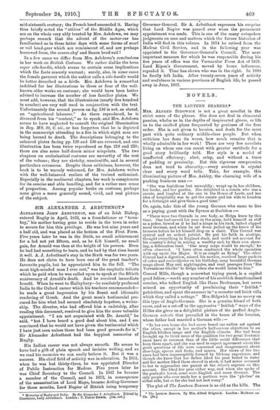MEDIAEVAL ENGLISH COSTUME.*
IN a truly remarkable manner the varying fashions of mediaeval costume come to be identified in, the student's mind with the social characteristics of the periods during which they prevailed. This, indeed, is no chance phenomenon of memory, but a very real indication of the sociological facts which lie ready—needing only to be sought—in the details of English mediaeval dress. We would insist upon this often neglected side of the subject,—its sociological importance. 'Take, for example, one of its most obvious interests : the history of taste, the aesthetic standards of different periods, and the manners and morals not remotely related thereto, are nowhere more engagingly recorded than in the intricate details of this thousand years of ever-varying costume. This, of course, is a view which it is impossible to exemplify in a short survey ; it is merely suggested here. For a brief instance of changing modes we may glance at the "attires," or head-dresses, of the mediaeval ladies. First came the Anglo-Saxon " head-rail," the scarf or veil which was passed over the crown of the head and grace- fully draped about the neck and shoulders. Later,, the falling ends of the veil were sometimes permitted to hang more loosely. As the couvre-chef we see an essentially similar head-dress continued; a modification fashionable in the first half of the twelfth century lent the veil a pronounced likeness to the knightly hood of mail. Then for rather more than a hundred years the wimple was combined with the couvre-chef to form a head-dress. (It will be remembered that the barbs, or gorget, and couvre-chef, allied as they were to the dress of nuns, survived in the garb of widowhood throughout the Middle Ages.) In the latter half of the thirteenth century we detect the beginning of a coiffure, as distinct from a head- dress. This introduced a new principle in the fabrication of head-gear, which had hitherto consisted of scarf and veil arrangements. The various cauls used to enclose the hair beneath the kerchief and gorget developed ultimately into the so-called nebula head-dress of the mid-fourteenth century; this was exposed to view when the kerchief was discarded and the gorget soon after cast aside. It is perhaps unnecessary to remark that there were many other varieties of coiffure which cannot be enumerated here. The type of head-dress known as the reticulated was a common form in the last twenty years of the fourteenth century. With the fifteenth century, roughly speaking, began the mode known as the crespine, which consisted of jewelled nets or cauls enclosing the hair on each side of the face, a veil being draped above and allowed to fall behind the head. The hennin, which appeared some twenty years later, included several forms evolved from the crespine. The varieties which have been called the " horned," " crescent," " heart-shaped," and " mitre" head-dresses may be named. These attires, together with the turban head-dress, enjoyed a considerable vogue ; in the latter half of the fifteenth century arose the notorious " steeple " mode, and about 1470 the " butterfly " head-dress. Finally the hood-like " pedimental," or "kennel," type came in, and persisted to about the • British Costume during Nineteen Centuries (Civil and Ecclesiastical). By Mrs. Charles H, Ashdown. With 439 Plates and Engravings and Qat:4,504 Aeproductfops, I4oacl9a i T. C. hat' V, C. Jack. pa. 6d. aet.1 mid-sixteenth century; the French hood succeeded it. Having thus briefly noted the "attires" of the Middle Ages, which are on the whole very ably treated by Mrs. Ashdown, we may perhaps remark that the advent of the motor-car has familiarised us in these latter days with some forms of scarf or veil bead-gear which are reminiscent of, and are perhaps borrowed from, the couvre-chef and Saxon head-rail !
In a few cases we differ from Mrs. Ashdown's conclusions in her work on British Costume. We rather dislike the term super cote-hardie, which seems to contain some implications which the facts scarcely warrant; surely, also, in some cases the female garment which the author calls a cote-hardie would be better described as a kirtle. Mrs. Ashdown is somewhat indebted for her illustrations to three or four of the well- known older works on costume; she would have been better advised to increase the number of less familiar plates. We must add, however, that the illustrations (nearly five hundred in number) are very well used in conjunction with the text. Unfortunately the second person on fig. 116 is not, as stated, an "agricultural labourer." As there reproduced, he is divorced from his "context," so to speak, and Mrs. Ashdown seems to have neglected to consult the original illumination in Roy. MS. 20, C. vii., or has forgotten that he is depicted in the manuscript attending to a fire in which eight men are being burned to death. The descriptions belonging to the coloured plates facing pp. 126 and 130 are reversed, and one illustration has been twice reproduced as figs. 218 and 230; there are also some half-dozen minor misprints. The two chapters on ecclesiastical costume are unworthy of the rest of the volume; they are sketchy, unscientific, and in several particulars erroneous. Despite these criticisms, however, the book is to be warmly welcomed, for Mrs. Ashdown writes with the well-balanced realism of the trained enthusiast. Especially in the mediaeval chapters, her work is conspicuous for its concise and able handling, and for a rather rare sense of proportion. Among popular books on costume, perhaps none gives a more generally sound, vivid, and real picture of the subject.











































 Previous page
Previous page